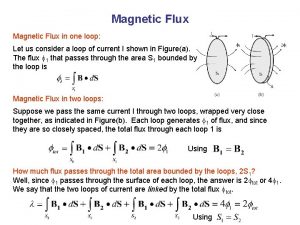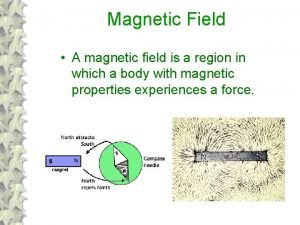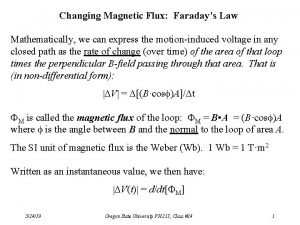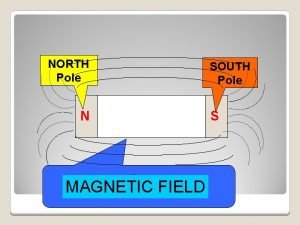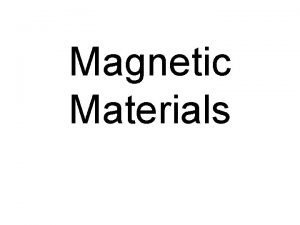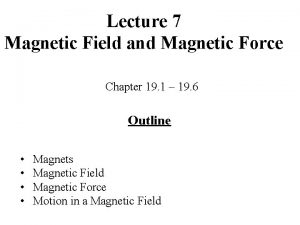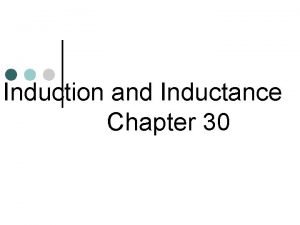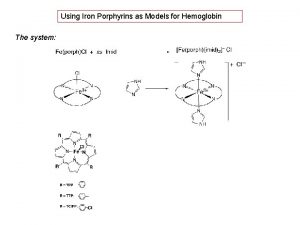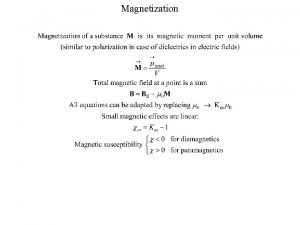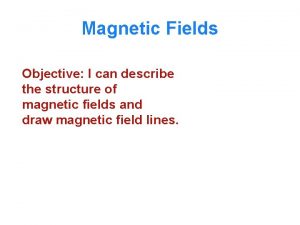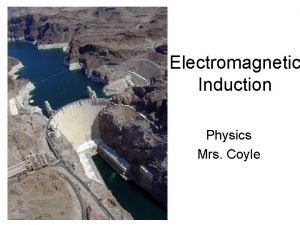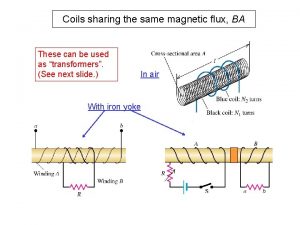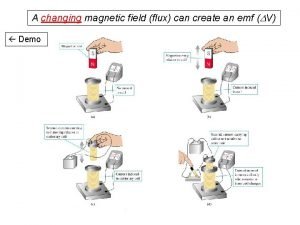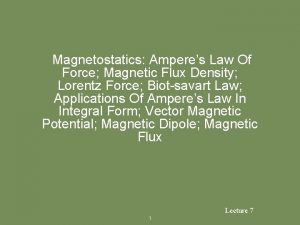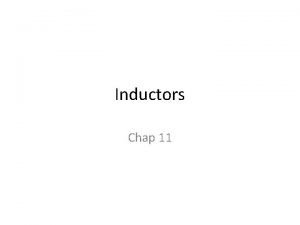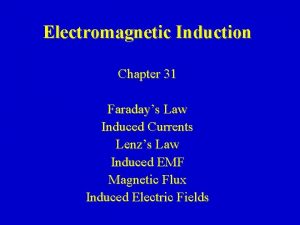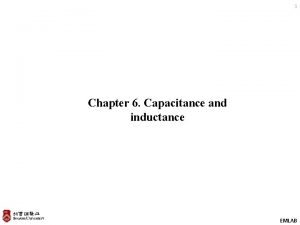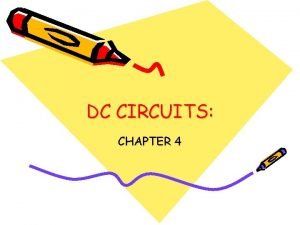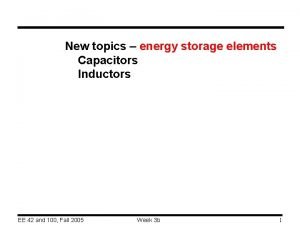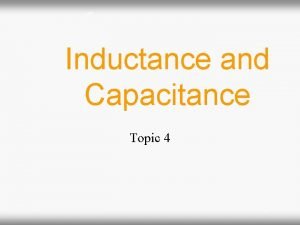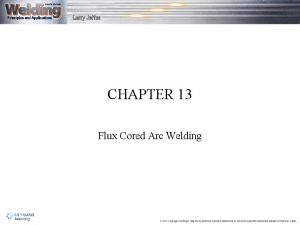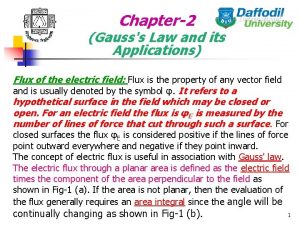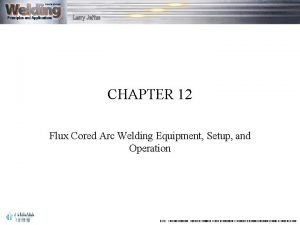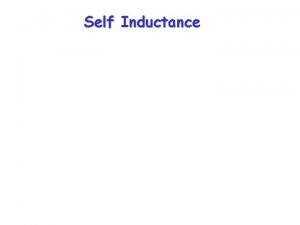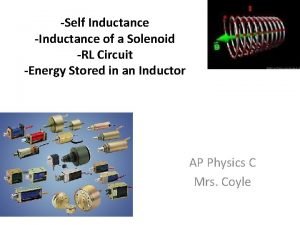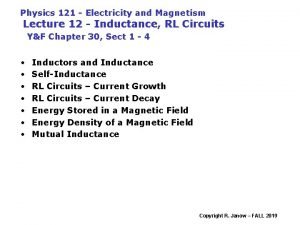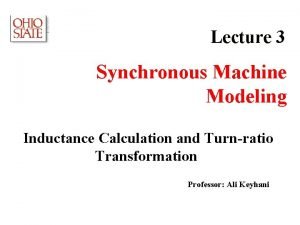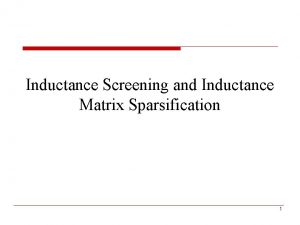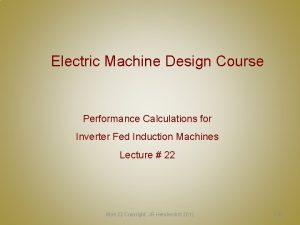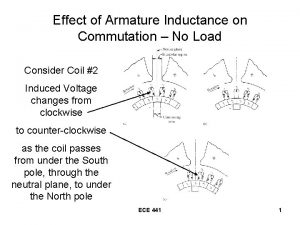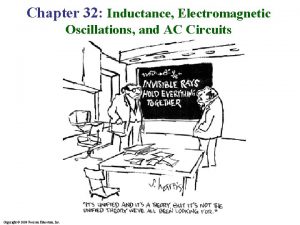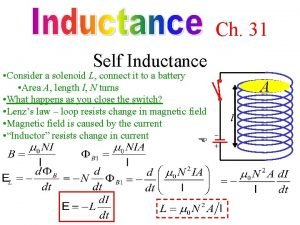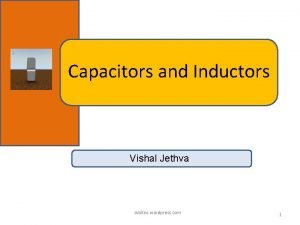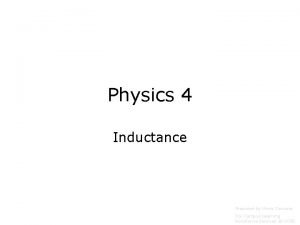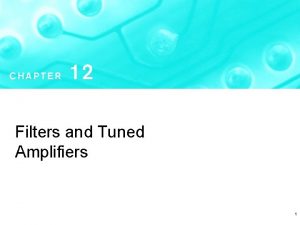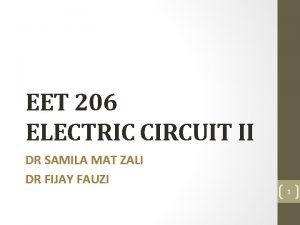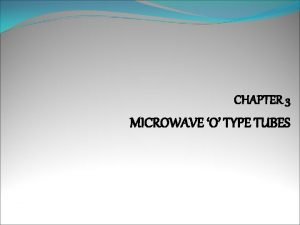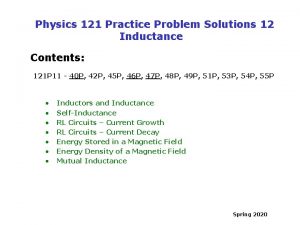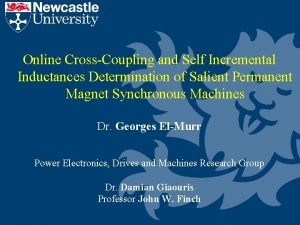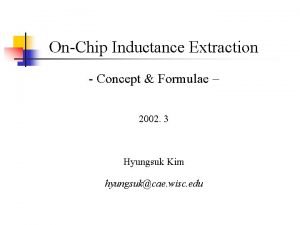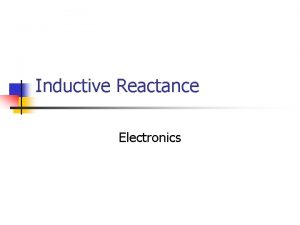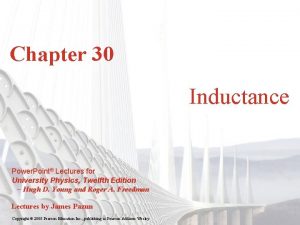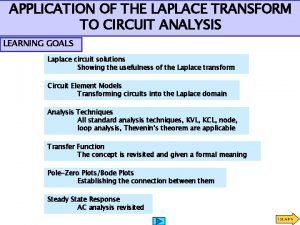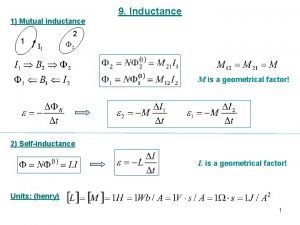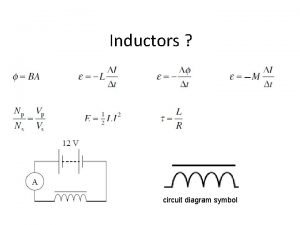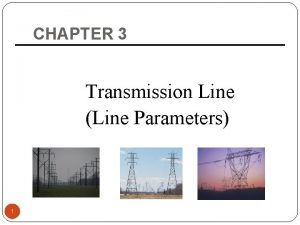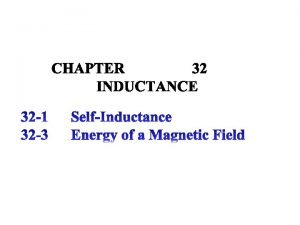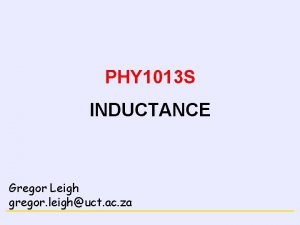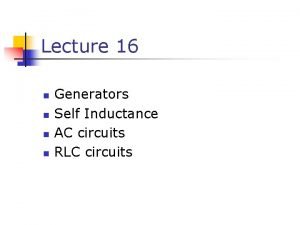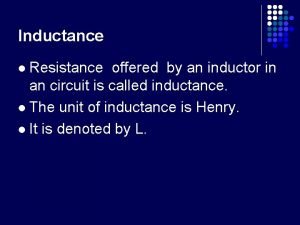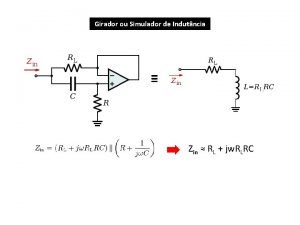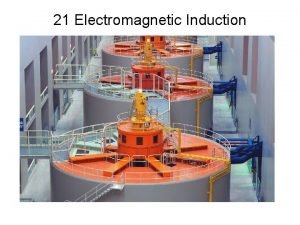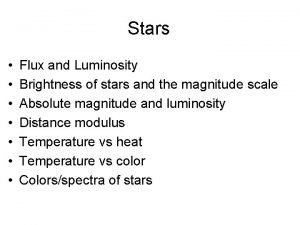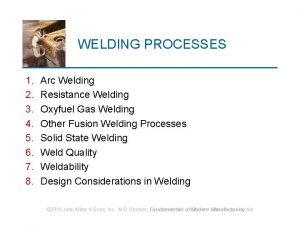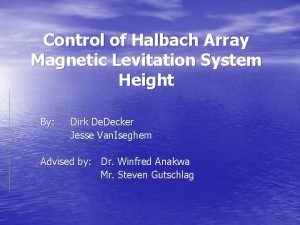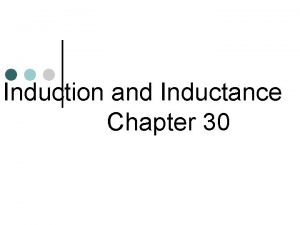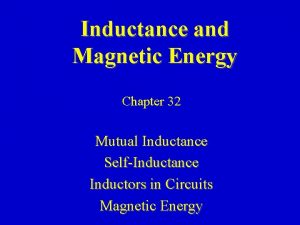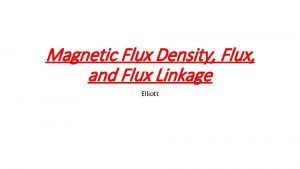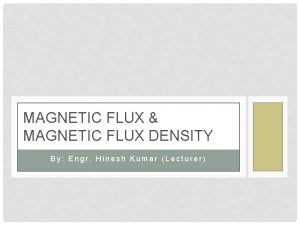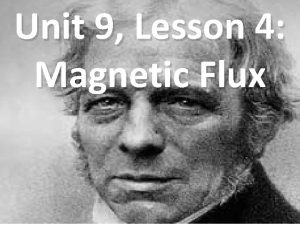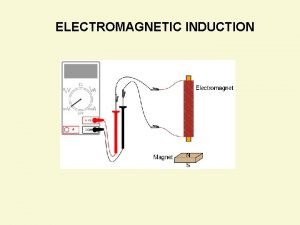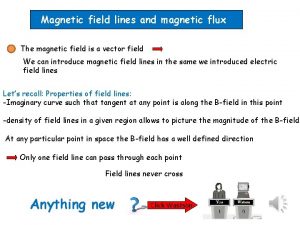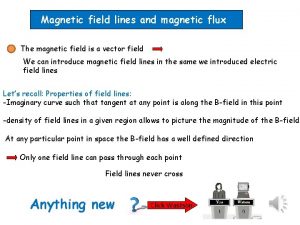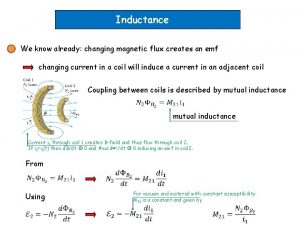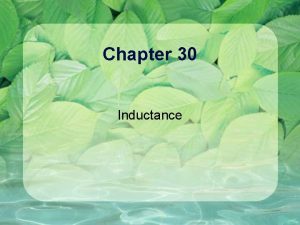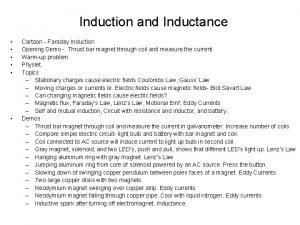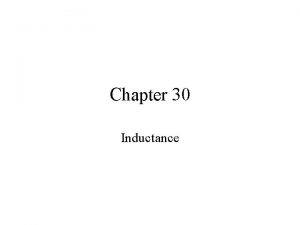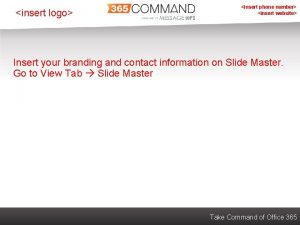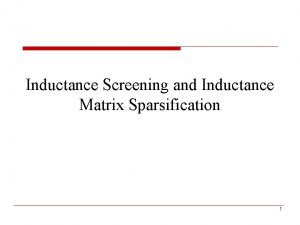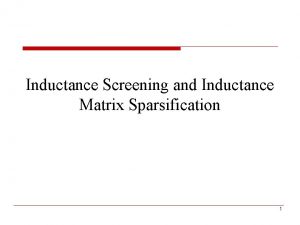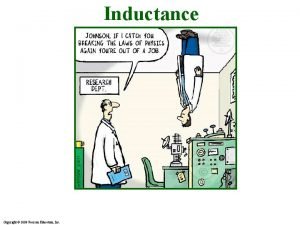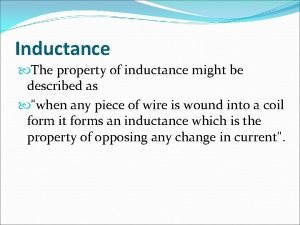Induction and Inductance Chapter 30 Magnetic Flux Insert




































































- Slides: 68

Induction and Inductance Chapter 30

Magnetic Flux

Insert Magnet into Coil

Remove Coil from Field Region

From The Demo. . First experiment Second experiment

Faraday’s Experiments ? ?

That’s Strange …. . These two coils are perpendicular to each other

Definition of TOTAL ELECTRIC FLUX through a surface:

Magnetic Flux: F THINK OF MAGNETIC FLUX as the “AMOUNT of Magnetism” passing through a surface.

Consider a Loop ¢ xxxxxxxxxxxxxxx xxxxxxxxxxxxxxx ¢ ¢ Magnetic field passing through the loop is CHANGING. FLUX is changing. There is an emf developed around the loop. A current develops (as we saw in demo) Work has to be done to move a charge completely around the loop.

Faraday’s Law (Michael Faraday) xxxxxxxxxxxxxxx xxxxxxxxxxxxxxx ¢ ¢ ¢ For a current to flow around the circuit, there must be an emf. (An emf is a voltage) The voltage is found to increase as the rate of change of flux increases.

Faraday’s Law (Michael Faraday) xxxxxxxxxxxxxxx xxxxxxxxxxxxxxx We will get to the minus sign in a short time.

Faraday’s Law (The Minus Sign) xxxxxxxxxxxxxxx xxxxxxxxxxxxxxx Using the right hand rule, we would expect the direction of the current to be in the direction of the arrow shown.

Faraday’s Law (More on the Minus Sign) xxxxxxxxxxxxxxx xxxxxxxxxxxxxxx The minus sign means that the current goes the other way. This current will produce a magnetic field that would be coming OUT of the page. The Induced Current therefore creates a magnetic field that OPPOSES the attempt to INCREASE the magnetic field! This is referred to as Lenz’s Law.

How much work? xxxxxxxxxxxxxxx xxxxxxxxxxxxxxx f m e A magnetic field an electric field are intimately connected. )

MAGNETIC FLUX This is an integral over an OPEN Surface. ¢ Magnetic Flux is a Scalar ¢ ¢ The UNIT of FLUX is the l 1 weber = 1 T-m 2 weber

We finally stated FARADAY’s LAW

From the equation Lentz

Flux Can Change ¢ ¢ If B changes If the AREA of the loop changes Changes cause emf s and currents and consequently there are connections between E and B fields These are expressed in Maxwells Equations

Maxwell’s Equations (chapter 32. . Just a Preview!) Gauss Faraday

Another View Of That hopeless minus sign again …. . SUPPOSE that B begins to INCREASE its MAGNITUDE INTO THE PAGE xxxxxxxxxxxxxxx xxxxxxxxxxxxxxx ¢ ¢ ¢ The Flux into the page begins to increase. An emf is induced around a loop A current will flow That current will create a new magnetic field. THAT new field will change the magnetic flux.

Lenz’s Law Induced Magnetic Fields always FIGHT to stop what you are trying to do!

Example of Lenz The induced magnetic field opposes the field that does the inducing!


Don’t Hurt Yourself! The current i induced in the loop has the direction such that the current’s magnetic field Bi opposes the change in the magnetic field B inducing the current.

Lenz’s Law An induced current has a direction such that the magnetic field due to the current opposes the change in the magnetic flux that induces the current. (The result of the negative sign!) …

#1 CHAPTER 30 The field in the diagram creates a flux given by FB=6 t 2+7 t in milli. Webers and t is in seconds. (a) What is the emf when (b) t=2 seconds? (c) (b) What is the direction (d) of the current in the (e) resistor R?

This is an easy one … Direction? B is out of the screen and increasing. Current will produce a field INTO the paper (LENZ). Therefore current goes clockwise and R to left in the resistor.

#21 Figure 30 -50 shows two parallel loops of wire having a common axis. The smaller loop (radius r) is above the larger loop (radius R) by a distance x >> R. Consequently, the magnetic field due to the current i in the larger loop is nearly constant throughout the smaller loop. Suppose that x is increasing at the constant rate of dx/dt = v. (a) Determine the magnetic flux through the area bounded by the smaller loop as a function of x. (Hint: See Eq. 29 -27. ) In the smaller loop, find (b) the induced emf and (c) the direction of the induced current. v

B is assumed to be constant through the center of the small loop and caused by the large one. q

The calculation of Bz q

More Work In the small loop: dx/dt=v

Which Way is Current in small loop expected to flow? ? B q

What Happens Here? ¢ ¢ ¢ Begin to move handle as shown. Flux through the loop decreases. Current is induced which opposed this decrease – current tries to reestablish the B field.

moving the bar

Moving the Bar takes work v

What about a SOLID loop? ? Energy is LOST BRAKING SYSTEM METAL Pull

Back to Circuits for a bit ….

Definition Current in loop produces a magnetic field in the coil and consequently a magnetic flux. If we attempt to change the current, an emf will be induced in the loops which will tend to oppose the change in current. This this acts like a “resistor” for changes in current!

Remember Faraday’s Law Lentz

Look at the following circuit: Switch is open ¢ NO current flows in the circuit. ¢ All is at peace! ¢

Close the circuit… After the circuit has been close for a long time, the current settles down. ¢ Since the current is constant, the flux through the coil is constant and there is no Emf. ¢ ¢ Current is simply E/R (Ohm’s Law)

Close the circuit… ¢ ¢ When switch is first closed, current begins to flow rapidly. The flux through the inductor changes rapidly. An emf is created in the coil that opposes the increase in current. The net potential difference across the resistor is the battery emf opposed by the emf of the coil.

Close the circuit…

Moving right along …

Definition of Inductance L UNIT of Inductance = 1 Henry = 1 T- m 2/A FB is the flux near the center of one of the coils making the inductor

Consider a Solenoid l n turns per unit length

So…. Depends only on geometry just like C and is independent of current.

Inductive Circuit i ¢ ¢ ¢ Switch to “a”. Inductor seems like a short so current rises quickly. Field increases in L and reverse emf is generated. Eventually, i maxes out and back emf ceases. Steady State Current after this.

THE BIG INDUCTION ¢ ¢ As we begin to increase the current in the coil The current in the first coil produces a magnetic field in the second coil Which tries to create a current which will reduce the field it is experiences And so resists the increase in current.

Back to the real world… Switch to “a” i

Solution

Switch position “b”

VR=i. R ~current Max Current Rate of increase = max emf

. n o ti he t e v l So p o o l ua q e

IMPORTANT QUESTION Switch closes. ¢ No emf ¢ Current flows for a while ¢ It flows through R ¢ Energy is conserved (i 2 R) ¢ WHERE DOES THE ENERGY COME FROM? ?

For an answer Return to the Big C E=e 0 A/d ¢ ¢ +dq +q ¢ -q ¢ We move a charge dq from the (-) plate to the (+) one. The (-) plate becomes more (-) The (+) plate becomes more (+). d. W=Fd=dq x E x d

The calc The energy is in the FIELD !!!

What about POWER? ? power to circuit Must be d. WL/dt power dissipated by resistor

So Energy stored in the Coil

WHERE is the energy? ? l

Remember the Inductor? ? ? ? ? ? ?


ENERGY IN THE FIELD TOO!

IMPORTANT CONCLUSION A region of space that contains either a magnetic or an electric field contains electromagnetic energy. ¢ The energy density of either is proportional to the square of the field strength. ¢

¢ 10. A uniform magnetic field B increases in magnitude with time t as given by Fig. 30 -43 b, where the vertical axis scale is set by Bs=9 m. T and the horizontal scale is set by ts=3 s. A circular conducting loop of area A= 8 x 10 -4 m 2 lies in the field, in the plane of the page. The amount of charge q passing point A on the loop is given in Fig. 30 -43 c as a function of t, with the vertical axis scale set by qs=3 m. C and the horizontal axis scale again set by ts=3 s. What is the loop's resistance?

29. If 50. 0 cm of copper wire (diameter=1 mm ) is formed into a circular loop and placed perpendicular to a uniform magnetic field that is increasing at the constant rate of 10. 0 m. T/s, at what rate is thermal energy generated in the loop?

 Magnetic permeability of materials
Magnetic permeability of materials Difference between magnetic flux and magnetic flux density
Difference between magnetic flux and magnetic flux density How to find magnetic flux
How to find magnetic flux Simple dc motor
Simple dc motor Express magnetic flux mathematically
Express magnetic flux mathematically Magnetic field intensity formula
Magnetic field intensity formula Coercive force magnetism
Coercive force magnetism Magnetic force si unit
Magnetic force si unit Magnetic flux formula
Magnetic flux formula Flux magnetic
Flux magnetic Magnetization formula
Magnetization formula F=bilsinθ
F=bilsinθ Magnetic flux
Magnetic flux Flux=ba
Flux=ba Ampere maxwell law
Ampere maxwell law Fundamental laws of magnetostatics
Fundamental laws of magnetostatics How to calculate magnetic force
How to calculate magnetic force What is faraday's law in physics
What is faraday's law in physics Magnetic moment and magnetic field relation
Magnetic moment and magnetic field relation Magnetic field and magnetic force
Magnetic field and magnetic force Inductance capacitance formula
Inductance capacitance formula Capacitors and inductors in dc circuits
Capacitors and inductors in dc circuits Capacitor equations
Capacitor equations Inductance energy
Inductance energy Welding chapter 13 answers
Welding chapter 13 answers Flux chapter 2
Flux chapter 2 Perpendicular welding
Perpendicular welding Magnetizing inductance
Magnetizing inductance Self-inductance formula for coil
Self-inductance formula for coil Energy density of solenoid
Energy density of solenoid Which statement describes the image?
Which statement describes the image? Magnetizing inductance
Magnetizing inductance Matrix sparsification
Matrix sparsification Magnetizing inductance
Magnetizing inductance The current in self inductance l=40mh
The current in self inductance l=40mh Armature inductance
Armature inductance Schering bridge equation
Schering bridge equation Inductance units
Inductance units Inductors in series
Inductors in series Finding equivalent inductance
Finding equivalent inductance Rl circuit current
Rl circuit current Bridged t network transfer function
Bridged t network transfer function Transformer dot convention
Transformer dot convention Lead inductance effect in microwave
Lead inductance effect in microwave Inductance practice problems
Inductance practice problems Incremental inductance
Incremental inductance Self inductance formula
Self inductance formula Inductance
Inductance Inductance
Inductance Laplace transform in circuit analysis
Laplace transform in circuit analysis Inductance factor
Inductance factor Inductor diagram symbols
Inductor diagram symbols The bundle gmr dsl of bundle conductor
The bundle gmr dsl of bundle conductor Self inductance formula
Self inductance formula Dot convention mutual inductance
Dot convention mutual inductance Inductance energy
Inductance energy Self inductance unit
Self inductance unit Inductance
Inductance Antoniou inductance simulation circuit
Antoniou inductance simulation circuit Relationship between current and capacitance
Relationship between current and capacitance Define mutual inductance of 1 henry
Define mutual inductance of 1 henry Recruitment selection and induction
Recruitment selection and induction Sql queries for insert update and delete
Sql queries for insert update and delete Recarbrio package insert
Recarbrio package insert Sqi english structure
Sqi english structure Luminosity/brightness
Luminosity/brightness Electrogas welding advantages and disadvantages
Electrogas welding advantages and disadvantages Halbach array flux diagrams and calculations
Halbach array flux diagrams and calculations Chapter 24 magnetism magnetic fundamentals answers
Chapter 24 magnetism magnetic fundamentals answers


